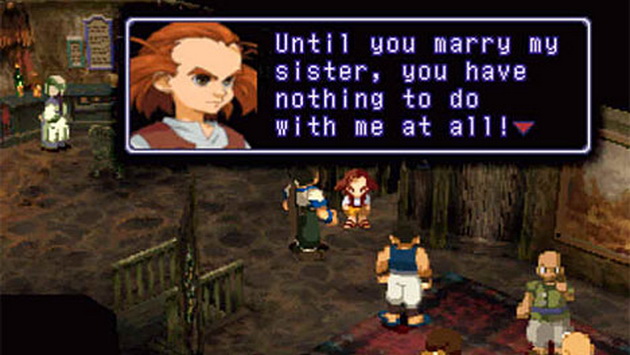For a certain time period, and a certain kind of gamer, Xenogears was the potential of the gaming industry to tell complex imaginative stories; unfortunately, it's a potential we'll likely never see realized. While games with greater emotional and intellectual storytelling have been emerging slowly over the past decade, and the production team behind Xenogears now has proper funding, the likelihood of a true sequel from them (spiritual or stylistic) remains in the dust, the history of which is heavily detailed in a four-part-series at Between Life and Games.
From 1999 until 2012, if you'd asked what my favorite video game was, the answer would have been fast, quick, and enthusiastic: Xenogears! Produced by Square and directed by Tetsuya Takahashi, released in 1998, Xenogears was a rarity that was perhaps a product of its time, a 2D-3D hybrid epic RPG that delved into psychological and emotional themes, with a labyrinthine plot that spanned millennia and didn't hold the player's hand. It borrowed as much from the same anime sources that Neon Genesis Evangelion did, as it did from Star Wars, the New Testament of The Bible, and the writings of Sigmund Freud, C.G. Jung, and Friedrich Nietzsche. It featured scenes of crucified robots, a villain literally named "Id," and a character frozen in carbonite; it was not subtle with its references. It was also unfinished; the second disk of the PSX classic featured giant sections where the story unfolded as reams of text that scrolled while the main characters sat in chairs in the backdrop.
One of the most astounding parts of Xenogears was its extensive mythology. As episode 5 of an extended saga, there was a planned set of six titles that were detailed in a development bible, released to the public as Xenogears: Perfect Works, which can be read in translation. However, as Square moved forward—before even incorporating with Enix—development on other Xenogears games stalled due to not reaching its quota (they would make a sequel if it sold a million copies, and it hit around 900K) as production for Final Fantasy games was ramped up with multiple teams producing games at the same time. Xenogears was kaput.
Takahashi, along with some other developers of Xenogears created their own company in 1999, Monolith Soft, and after securing funding from Bandai Namco, Takahashi and co. revamped their ideas from the Xenogears: Perfect Works timeline to fit their new franchise, while being careful not to step on Square-Enix's copyrighted material. Xenosaga was shortly announced afterward with six planned games across three different arcs, two games per arc.
The first, Xenosaga Episode I: Der Wille zur Macht (Trans. from German: The Will to Power, from the book by Nietzsche, 2002), is a fascinating game. Written by Takahashi and his wife, Xenogears co-writer Soraya Saga, it continues to explore the same themes as Xenogears, but starting from the first episode information listed in Xenogears: Perfect Works. Clearly inspired by the symbolism of Christian iconography, Stanley Kubrick's 2001, and the sci-fi films of Andrei Tarkovsky, and featuring excellent music by Yasunori Mitsuda, it has truly profound moments. Like its more esoteric sources of inspiration, it's best when it delves into more abstract, psychologically difficult material, but at times seems bogged down, and felt like it ended in the middle of the first act.
Perhaps Takahashi had bitten off more than he could chew, planning for a 80-hour RPG, developed in 3D with voice acting; the final game was about half of what was intended, coming in at about 35 hours. He later admitted the game was 20% of the planned two-game scenario (or only 40% of the material they planned for first title). When the game was released and underperformed in Japan, Monolith Soft was reorganized—replacing composer Yasunori Mitsuda completely—and Takahashi and Saga's roles were reduced, resulting in them writing the first draft of the story of the next title, comprising mostly the material cut from Episode I. The rest of the game was then heavily rewritten and one of the support characters became the protagonist. Xenosaga's scope was also heavily reduced, so that instead of the planned three arcs, they would only complete the first one.
If Xenosaga Part 1 was poorly received, Xenosaga Episode II: Jenseits von Gut und Bose (Beyond Good and Evil, 2004) was considered a disaster, and fans demanded a return of the style of the original for the third (and now final) game. Xenosaga Episode III: Also Sprach Zarathustra (Thus Spoke Zarathustra, 2006), apparently did return to the original scenario written by Takahashi and Saga for the ending of the sequence, though their roles were still diminished, with Saga not returning for the final game at all. Whole sections of game narrative were missing, and had to be provided in a flash video and text. One important part of the planned narrative was turned into a cellphone game—Xenosaga: Pied Piper—with minimal changes from the original story and was only released in Japan. Part 3 was not released in Europe.
Meanwhile Takahashi had moved on, working on the smaller DS title, Soma Bringer, again with Saga and composer Yasunori Mitsuda. Monolith Soft was developing a positive relationship with Nintendo. After the demand for a return to the style of Xenosaga 1 for Xenosaga 3, a revamped version of the first two games, Xenosaga I & II (2006), was put into production as a single game for the Nintendo DS that hewed closer to Takahashi's and Saga's vision, and included material cut from Xenosaga 2. Ironically, this DS title may be the best representation of the plans for the first Xenosaga title, but was not made available in the US, and reportedly plays kind of like a 20-hour crib-sheet for the Xenosaga story.
In spite of the fractured storytelling, Xenosaga still has an intensely dedicated fanbase. As recently as last year there was news of a petition to see an internationally released HD Xenosaga remake from Bandai Namco, under the name Operation KOS-MOS. This was no doubt bolstered by the success of Operation Rainfall, a campaign from fans of JRPGs that convinced Nintendo and publisher XSEED there was enough interest in North America to see the release of three Wii JRPGs (two of them mentioned below) that had not been scheduled for release in the territory. The Xenosaga HD petition appears to have stalled, about halfway to the 20,000 signatures mark it aimed for, at the time of this article.
The poor sales numbers and development game of musical chairs amounted to an upset for the Monolith Soft team that had wanted to tell a massive 480-hour tale split into six triple-A games, spanning thousands of years. With most of their non-Xeno titles being published on Nintendo platforms and the positive relationship between the two, Nintendo purchased Monolith Soft in 2007, where in addition to their own titles, they provided support on development of major Nintendo titles (Zelda: Link Between Worlds, Splatoon, etc.). Takahashi and co. had already begun working on his next game, Monado: The Beginning of the World, in 2006, after completing Soma Bringer.
More exploratory, and a stylistic mimic of Western RPGs, Takahashi expected to have to cut corners, but was surprised when Nintendo extended development time and resources to allow him to finish the game. Poetically fitting, he had an informal, friendly competition with his former Square supervisor and friend Hironobu Sakaguchi (the creator of Final Fantasy, who left Square during the development of Final Fantasy X to start his own company, Mistwalker Studios that was then developing The Last Story) to see whose Nintendo Wii RPG would be completed first. Perhaps because of the extension and greater personal freedom in developing the title, late in development Monado was renamed Xenoblade Chronicles (2010), and this is probably the reason we will never see another Xenogears or Xenosaga title.
Xenoblade Chronicles has a massively different structure and style from Xenogears or Xenosaga, with a focus on exploratory gameplay over plot. While Xenoblade Chronicles moved fewer units than the most successful Xenosaga titles, it was also the first title major title helmed by Takahashi that he was actually allowed to finish. It's no surprise that the studio's follow-up, Xenoblade Chronicles X, not only not only embraces the same design cues, but takes them further with the customizable silent protagonist, a focus on more complex, integrated systems, and less complex and dense plotting.
So we may never get a true Xenogears/saga sequel, due to a simple lack of creative or financial incentive to make one. However, as more complex narratives and archetypes in games are emerging, perhaps there will eventually be a place for the legacy of Xenogears to live on in the works of those it has inspired. Well, one can hope, anyway. Takahashi has turned his eye to a different kind of game, and while it may not challenge the player intellectually, its massive scope and visual beauty shows that as a creator, he remains a visionary.







